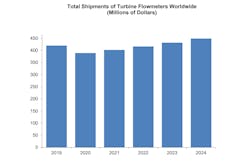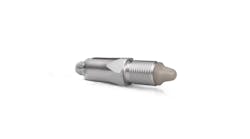Wakefield, Massachusetts; December 15, 2022 (Flow Research release) — Turbine flowmeters, a mainstay in oil and gas and water and industrial liquids markets, are still showing growth even though they are not keeping pace with the rapid growth in the new-technology markets, according to a new study by Flow Research. The World Market for Turbine Flowmeters, 3rd Edition found that the worldwide turbine market totaled $420 million in 2019 and forecasts a compound annual growth rate (CAGR) of just over one percent through 2024. New-technology meters are growing substantially faster, with a CAGR of up to 4.8%.
The turbine meter is expected to continue to grow due to a large installed base, the meter’s ability to measure both liquid and gas flow, industry approvals for custody transfer, and technology improvements.
Even though turbine flowmeters are losing ground to some new-technology flowmeters, especially Coriolis, ultrasonic, and magnetic flowmeters, they still remain an excellent choice for clean, steady, medium to high-speed flows of low-viscosity fluids.
Turbine meters are widely used in custody transfer and non-custody transfer applications of natural gas in upstream and downstream production environments, often measuring gas flow on large gas pipelines that carry natural gas from its source to its destination – in some cases for thousands of miles. Turbine meters are also used as billing meters to measure the amount of gas used at commercial buildings and industrial plants. Turbine meters for liquids measure water use in commercial businesses and industrial plants, as well as in hotels, office buildings, and apartment complexes.
Besides water and oil, turbine meters also measure process liquids, including pharmaceutical chemicals, paints and varnishes, industrial chemicals, dairy products, printing ink, cosmetics, and many other liquids. In many cases, turbine meters provide a highly accurate measurement but are less expensive than other meters such as Coriolis or magnetic. Turbine meters are used for higher flowrate measurements of process liquids than positive displacement (PD) meters, which are often used for to measure flow at lower flowrates.
Turbine flowmeters are quite accurate and have a significant cost advantage over ultrasonic and Coriolis flowmeters, especially in larger line sizes. Unlike new-technology meters, however, turbine meters have moving parts and require periodic maintenance. Turbine meters also have difficulty tolerating viscous fluids – a problem often encountered in the measurement of crude oil in the now recovering petroleum energy business. End users are also attracted by the high accuracy of new-technology meters.
Although research and development for turbine meters is less than the significant R&D for new-technology meters, some turbine meter suppliers are actively introducing new features and products. Innovations include new bearing types, different rotor designs, dual rotors, and bi-directional capability. Suppliers are also introducing wireless technology and more communication protocols.
Axial flowmeters lead the pack
Axial flowmeters, widely used for custody transfer of natural gas, are the fastest growing type of turbine flowmeter. Helical turbine meters, which have recently found a niche in the petroleum industry for high-viscosity fluids like oil, are benefitting from the upsurge in the oil industry. In general, insertion turbine meters of various types, often used in large line sizes for custody transfer, have been growing slightly faster than inline turbine meters.
Propeller, paddlewheel, and Pelton wheel flowmeters, used in water & wastewater, agriculture, and other large-scale applications, are growing more slowly. In some cases, a demand for better system integration through electronics and for devices with no moving parts is prompting agricultural customers to choose magnetic over turbine flowmeters. At the same time, as water becomes a scarcer commodity and people realize the need to measure it more closely, both in agricultural and commercial applications, the water industry could become a potential growth industry for turbine meters.
The market for multi-jet and single jet turbine meters, widely used for water flow measurement in commercial and industrial applications is very stable. Compound meters, which incorporate both positive displacement and turbine flowmeter technology to measure fluctuating low and high flow rates, also enjoy a steady market.
According to Dr. Jesse Yoder, president of Flow Research: “The turbine flowmeter market has seen a lot of technology improvements in the past ten years. Suppliers are making turbine flowmeters more reliable by improving their materials of construction, introducing self-diagnostics, and adding more communication protocols. Ceramic and synthetic sapphire ball bearings improve the life span of ball bearings. Dual rotor designs improve measurement accuracy, especially at low flowrates. Turbine meters continue to account for a significant portion of the market for custody transfer of natural gas. With a large installed base, the prospects for future growth in the turbine flowmeter market remain bright.”
The World Market for Turbine Flowmeters, 3rd Edition includes market size and forecasts, detailed segmentation, a technology analysis, market shares of major suppliers, average selling prices, supplier profiles, product analyses, discussions of market circumstances and growth factors, and strategies for success for companies competing in this market. Although we use 2019 as the starting base year, the market size data also includes 2020 data, and takes company input and available 2021 data into consideration in making forecasts through 2024.
This third edition builds on earlier editions published in 2002 and 2012. Flow Research also includes detailed information on the turbine market in every edition of Volume X: The World Market for Flowmeters, our market study that includes all types of flowmeters. In this third edition of our turbine flowmeter market study, we explore in depth a range of important market and technology factors and topics.
About Flow Research
Flow Research (www.flowresearch.com) is the only independent market research company whose primary mission is to research flowmeter and other instrumentation products and markets worldwide. Flow Research, founded in 1998 in Wakefield, Massachusetts, specializes in flow measurement devices, and conducts market research studies in a wide variety of instrumentation areas. These studies are developed through interviews with suppliers, distributors, and end users. Topics include all of the flowmeter technologies – both new and conventional – as well as temperature sensors, temperature transmitters, level products, and pressure transmitters. The company has a special focus on the energy industries, especially on oil and gas production and measurement.


